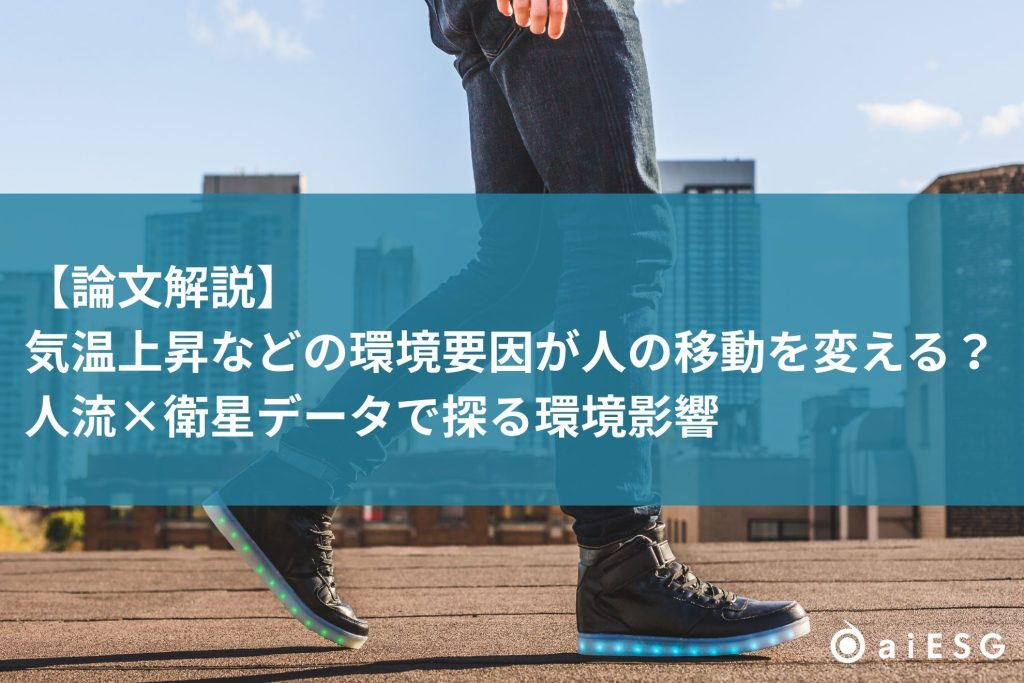INDEX
This is a Japanese translation of a manuscript written by aiESG's ESG research team and edited into three parts for publication. The English version of the manuscript isthis way (direction close to the speaker or towards the speaker)You can view it from
Please see the original article in English here.
Table of Contents:
Introduction.
ESG-oriented supply chains: necessary steps and challenges
Technical Solutions
aiESG's Solutions
Conclusions and Future Prospects
Introduction.
This three-part series, "Sustainable ESG-Oriented Supply Chains: A Strategic Imperative for Modern Business," covers the relationship between supply chains and society and the environment, the impact that promoting sustainable supply chains can have on companies, and how to develop action plans to promote them.
So far, we have presented the following topics on two occasions
Part 2: Sustainable ESG-oriented supply chains: a strategic imperative for modern business
〜˜ What are the main drivers from the three perspectives of academia, business, and the public?
In this third edition, we will discuss the necessary steps companies need to take to promote ESG-oriented supply chains and the challenges they face along the way. The importance of IT solutions, including AI, in sustainable supply chain management will also be presented, including cutting-edge technologies from aiESG. Finally, we will provide a brief overview of recent noteworthy trends in supply chain.
ESG-oriented supply chains: necessary steps and challenges
<Recommendations from experts and academia
Many academic studies and experts agree that companies need to take the following steps to understand and improve their supply chain ESG performance
interpoint (interword separation)Measurement and Monitoring (Collect data on ESG performance indicators)
interpoint (interword separation)Supplier Engagement (Communicate expectations of regulatory compliance and ethical and sustainable standards to business partners)
interpoint (interword separation)Procurement Decision (Consider working conditions, ESG impacts of transportation methods, and transparency of materials used when procuring)
interpoint (interword separation)Supplier Management Program (Periodic review of counterparty performance based on metrics)
interpoint (interword separation)Sustainable Supply Chain Management Strategies(Set effective strategies and goals)
<Importance and difficulties of the initial stage
While there are various recommendations on what steps to take, most follow a simple scheme of "gather information → mobilize resources and develop an action plan → implement actions → monitor". The first step that most companies must first focus on is "gathering information," and many are currently struggling with this.According to academic researchThe "information gathering" phase includes the following actions
Get Consulting
Understanding Sustainability and ESG
Gather facts to understand where changes are needed
Evaluate the current stage
Identify the types of changes needed
Identify regulatory and compliance requirements
Identify ESG risks
Identify opportunities
However, due to the complexity of the supply chain and the lack of ESG expertise within companies, it is this "gathering information" and "getting the facts" phase that many companies currently struggle with. Companies first need to understand the ESG risks in their supply chain by mapping the supply chain and identifying key risk hotspots*. However, this is difficult without the necessary expertise and tools.
*Risk hotspots are areas in the supply chain that are particularly vulnerable to disruption due to high exposure to environmental, social, economic, or operational risks.
According to the surveyPurchasing managers feel pressure to understand the need to reduce negative environmental and social impacts throughout the supply chain, but it is not clear how to begin addressing them. In addition, companies face challenges such as financial constraints, high costs, confusion caused by many ESG frameworks and standards, lack of skills, and lack of external support.
As a result, supply chain professionals are nowadays eager to take advantage of cost-effective IT technology solutions that can help them take the first steps toward ensuring sustainability in their supply chain operations.
Technical Solutions
<IT solutions can help companies initiate response strategies by providing clarity and strategic insight into the complex issue of sustainable supply chain management.
The above issues show that external consulting and IT solutions are essential for companies to assess and improve their supply chain ESG performance.According to the experts who conducted the studyMany CEOs agree that it is important to use information technology to improve supply chain sustainability.
Even though the majority of a company's environmental and social impacts stem from its supply chain activities, most companies do not know the scale of their impacts or where the greatest risks lie. In fact, many companies know nothing about anything other than their direct Tier 1 suppliers. While mapping supply chains beyond direct suppliers may seem complex and difficult, the reality is that significant impacts are concentrated in a small number of suppliers with high ESG risks. Therefore, companies can prioritize efforts from these high-risk suppliers to make the entire supply chain more sustainable.
Therefore, a thorough supply chain analysis is necessary to identify opportunities for improving sustainability. Sustainable supply chain management requires very detailed attention, and the right digital tools and external assistance are essential to understand the complex structures and relationships.
ESG activities require significant corporate resources, time, money, and effort. A comprehensive approach to a sustainable supply chain often seems like it can only be implemented by financially rich companies. Many companies use semi-manual tools such as supplier surveys to map and assess ESG risks, but despite the cost and time involved, they can only collect information from a small number of direct suppliers who respond to the survey. However, companies usually need to look beyond Tier 1 suppliers to get a complete picture of their supply chain. Without a thorough analysis of ESG impacts throughout the entire lifecycle of their products/services, it is impossible to get a complete picture of the supply chain and where the major ESG risk hotspots are located.
There can be thousands of nodes in a modern supply chain. In addition, manual management of these data will soon become unfeasible as companies must account for an increasing number of relevant ESG indicators such as GHG emissions, water consumption, and human rights risks such as child labor.
aiESG's Solutions
< aiESG offers unique AI solutions based on cutting-edge scientific research.
Fortunately, the integration of cutting-edge academic research with big data and AI has led to a new generation of tools to help companies with these challenges. aiESG is proud to be the first product-focused ESG visualization solution in Japan and the first in the world to help companies assess their ESG impacts, whether from raw material sources or throughout the entire product or service life cycle. We are proud to be Japan's first and the world's first product-focused ESG visualization solution that helps companies assess their ESG impacts throughout the entire lifecycle of their raw material sources or products and services.
The ESG visualization model for products/services built by aiESG's proprietary know-how enables companies to understand the current status of their product/service supply chains and create schematic models based on reliable statistical data and scientific approaches, and visualize them for regulatory compliance and information disclosure purposes. The product/service lifecycle model built by aiESG can trace raw materials back to their source and understand their ESG impact throughout the supply chain. Using this model, companies can use it for a variety of purposes, including
...By understanding the approximate structure of the supply chain, companies can begin to create an extended supply chain map. This will allow companies to work with their trading partners (and secondary and tertiary trading partners) to collaborate on improving sustainability performance throughout the value chain.
By understanding which ESG impacts are greatest and where they lie, companies can improve their risk management. This allows companies to understand the weak points in their value chain.
Through supplier engagement, companies can optimize their supply chain operations by addressing high-risk hot spots and developing new sourcing channels.
With these insights, companies can plan for compliance with an increasing number of regulations. It also enables them to implement disclosures.
In addition to this, companies can use aiESG's expert services in a variety of other ways. In short, aiESG provides state-of-the-art solutions to help companies "gather information," the first step toward a sustainable supply chain. This enables companies to gain valuable insights at low cost, leading to increased corporate value that improves the ESG performance of their supply chains.
Conclusions and Future Prospects
In this series, we have looked at how the trend toward more sustainable and ESG-oriented supply chain operations is evolving, what is driving the trend (e.g., objective pressures, internal corporate motivations, increased risk of inaction), what steps companies should take in response, and the challenges they face, and a closer look at how modern technology solutions can assist companies. We also touched on how aiESG services are a low-cost and useful solution for companies planning to address supply chain sustainability, especially in the early stages.
Finally, based on aiESG's research, we will briefly discuss three major upcoming trends related to the supply chain.
First, public scrutiny will undoubtedly become more intense and more regulated. This will force companies to assess, improve, and report on their supply chain performance. A voluntary reporting framework will become not just a good business practice, but a necessity to remain competitive. Legislation currently in discussion and testing stages in several developed countries will become more widespread and impossible to ignore.
Second, from a consumer perspective, the market niche of "ethical products" and "ethical industries" is growing as awareness and demand for ethically manufactured products increases. For example, the "ethical fashion" and "sustainable fashion" trends are growing rapidly in the apparel industry.Patagonia(an American outdoor clothing retailer) andAvantii.(a Japanese fashion company specializing in organic cotton) and other brands are making great strides in this competitive market.
Finally, social aspects, particularly human rights considerations, are becoming increasingly important. A recent academic review (Truant et al. 2024), the debate in the ESG arena is steadily shifting from "financial performance" and "environmental sustainability" to "social disclosure". Recent legislation in the European Union (German Supply Chain Lawand ... andCorporate Sustainability Due Diligence Directiveand others) require companies to conduct human rights due diligence across their suppliers, and leading companies such as Apple, Fast Retailing (UNIQLO, GU), and Mercedes-Benz Group have already begun pioneering efforts in this direction.
This is the third in a three-part series on "Sustainable ESG-Oriented Supply Chains: A Strategic Imperative for Modern Business". We hope that you have gained some useful insights. In the next installment of this series, we will discuss trends in human rights due diligence in supply chains, present case studies of leading companies, and explain how aiESG can assist companies in planning their due diligence processes. Please watch for our next issue.
__
aiESG supports ESG analysis at the product and service level, tracing back through the supply chain. We also provide support for ESG-related frameworks, from basic content to actual disclosure of non-financial information.
Contact us:https://aiesg.co.jp/contact/
*Related Article*.
Part 1: Sustainable ESG-oriented supply chains: a strategic imperative for modern business
〜Environmental and social impacts of the supply chain
Part 2: Sustainable ESG-oriented supply chains: a strategic imperative for modern business
〜˜ What are the main drivers from the three perspectives of academia, business, and the public?
Seminar Report】Ask a Pioneer on the Frontlines of Carbon Neutrality: Dejima Organization and ESG Management Creating a New Global Trend
[Commentary] The Impact of the U.S. Inflation-Reduction Act (IRA) on the ESG of Japanese EV Manufacturers (aiESG Analysis)
[Commentary] Nikkei article: aiESG Supply Chain Analysis of "Electric Vehicle (EV) Production, ESG Indicators Deteriorate Due to 'De-China'".
Part 2: What services does aiESG provide?
Part 1 Background of aiESG
Commentary] Overview of the European Corporate Sustainability Due Diligence Directive (CSDDD) and its Amendments
Understanding the European Corporate Sustainability Due Diligence Directive (CSDDD): Mandatory Assessment of Adverse Effects on Human Rights and the Environment
















